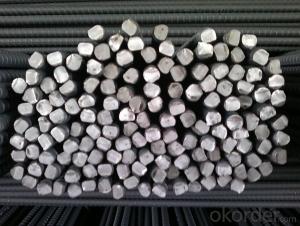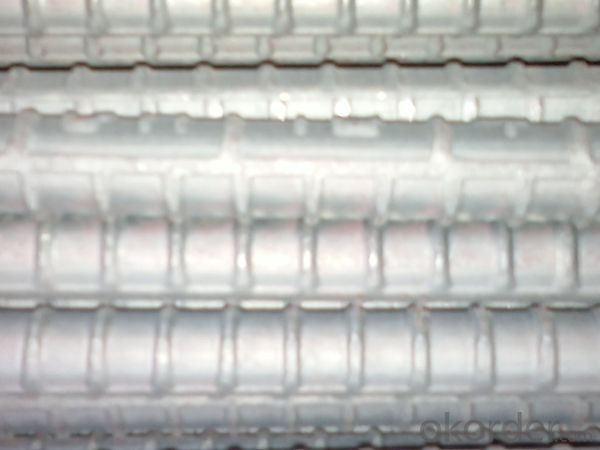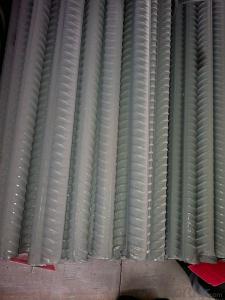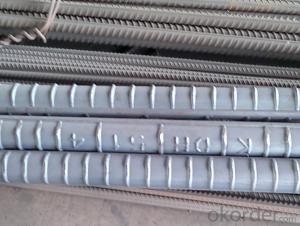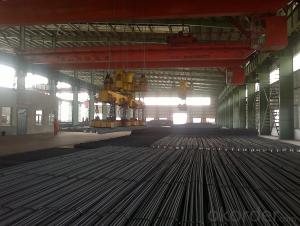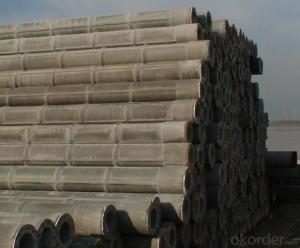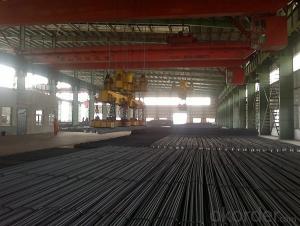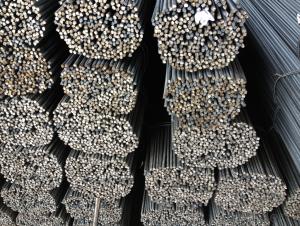Hot Rolled GB Standard Deformed Steel Rebars for Construction
- Loading Port:
- Tianjin
- Payment Terms:
- TT OR LC
- Min Order Qty:
- 25 m.t.
- Supply Capability:
- 200000 m.t./month
OKorder Service Pledge
OKorder Financial Service
You Might Also Like
Product Description:
OKorder is offering Hot Rolled GB Standard Deformed Steel Rebars for Construction at great prices with worldwide shipping. Our supplier is a world-class manufacturer of steel, with our products utilized the world over. OKorder annually supplies products to European, North American and Asian markets. We provide quotations within 24 hours of receiving an inquiry and guarantee competitive prices.
Product Applications:
Hot Rolled GB Standard Deformed Steel Rebars for Construction are ideal for structural applications and are widely used in the construction of buildings and bridges, and the manufacturing, petrochemical, and transportation industries.
1. Supporting members, most commonly in the house raising industry to strengthen timber bears under houses. Transmission line towers, etc
2. Prefabricated structure
3. Medium scale bridges
4. It is widely used in various building structures and engineering structures such as roof beams, bridges, transmission towers, hoisting machinery and transport machinery, ships, industrial furnaces, reaction tower, container frame and warehouse etc.
Product Advantages:
Hot Rolled GB Standard Deformed Steel Rebars for Construction are durable, strong, and resist corrosion.
Main Product Features:
· Premium quality
· Prompt delivery & seaworthy packing (30 days after receiving deposit)
· Corrosion resistance
· Can be recycled and reused
· Mill test certification
· Professional Service
· Competitive pricing
Product Specifications:
Our supplier is a world-class manufacturer of steel, with our products utilized the world over. OKorder annually supplies products to European, North American and Asian markets. We provide quotations within 24 hours of receiving an inquiry and guarantee competitive prices.
Product Applications:
High Quality Hot Rolled Equal Angle Steel Bars for Strcuture are ideal for structural applications and are widely used in the construction of buildings and bridges, and the manufacturing, petrochemical, and transportation industries.
1. Supporting members, most commonly in the house raising industry to strengthen timber bears under houses. Transmission line towers, etc
2. Prefabricated structure
3. Medium scale bridges
4. It is widely used in various building structures and engineering structures such as roof beams, bridges, transmission towers, hoisting machinery and transport machinery, ships, industrial furnaces, reaction tower, container frame and warehouse etc.
Product Advantages:
High Quality Hot Rolled Equal Angle Steel Bars for Constrcution are durable, strong, and resist corrosion.
Main Product Features:
· Premium quality
· Prompt delivery & seaworthy packing (30 days after receiving deposit)
· Corrosion resistance
· Can be recycled and reused
· Mill test certification
· Professional Service
· Competitive pricing
Product Specifications:
Specifications of Hot Rolled GB Standard Deformed Steel Rebars for Construction:
Standard | GB UK USA | HRB335 HRB400 HRB500 G460B, B500A, B500B,B500C GR40, GR60 | |
Diameter | 6mm,8mm,10mm,12mm,14mm,16mm,18mm,20mm, 22mm,25mm,28mm,32mm,36mm,40mm,50mm | ||
Length | 6M, 9M,12M or as required | ||
Packing | Export standard packing: wrapped by wire rod in bundles | ||
Each bundle weight | 2-3MT, or as required | ||
Trade terms | FOB, CFR, CIF | ||
Payment terms | TT payment in advance or Irrevocable LC at sight. | ||
Delivery Detail | within 45 days after received advanced payment or LC. | ||
Brand name | DRAGON | ||
Theoretical weight and section area of each diameter as below for your information:
Diameter(mm) | Section area (mm²) | Mass(kg/m) | Weight of 12m (kg) | Pcs/ton |
6 | 28.27 | 0.222 | 2.664 | 375.38 |
8 | 50.27 | 0.395 | 4.74 | 210.97 |
10 | 78.54 | 0.617 | 7.404 | 135.06 |
12 | 113.1 | 0.888 | 10.656 | 93.84 |
14 | 153.9 | 1.21 | 14.52 | 68.87 |
16 | 201.1 | 1.58 | 18.96 | 52.74 |
18 | 254.5 | 2.00 | 24 | 41.67 |
20 | 314.2 | 2.47 | 29.64 | 33.74 |
22 | 380.1 | 2.98 | 35.76 | 27.96 |
25 | 490.9 | 3.85 | 46.2 | 21.65 |
28 | 615.8 | 4.83 | 57.96 | 17.25 |
32 | 804.2 | 6.31 | 75.72 | 13.21 |
36 | 1018 | 7.99 | 98.88 | 10.43 |
40 | 1257 | 9.87 | 118.44 | 8.44 |
50 | 1964 | 15.42 | 185.04 | 5.40 |
Chemical Composition: (Please kindly find our chemistry of our material based on JIS as below for your information)
JISG3112 SD390 | Chemical Composition | ||||
C | Mn | Si | S | P | |
0.22 | 1.38 | 0.4 | 0.014 | 0.022 | |
Physical capability | |||||
Yield Strength(N/cm²) | Tensile Strength(N/cm²) | Elongation (%) | |||
620 | ≥400 | 21 | |||
The production process of Steel Rebar

1-Waling beam furnace 2-Roughing rolling group 3-Intermediate rolling train
4-Finishing rolling group 5-Water-cooling device 6-Walking beam cooler
7-Finishing equipment(including the cold scale shear,short feet collection system,
automatic counting device,bundling machine, collect bench)
Usage and Applications of Hot Rolled GB Standard Deformed Steel Rebars for Construction:
Deformed bar is widely used in buildings, bridges, roads and other engineering construction. Big to highways, railways, bridges, culverts, tunnels, public facilities such as flood control, dam, small to housing construction, beam, column, wall and the foundation of the plate, deformed bar is an integral structure material. With the development of world economy and the vigorous development of infrastructure construction, real estate, the demand for deformed bar will be larger and larger..
Packaging & Delivery of Hot Rolled GB Standard Deformed Steel Rebars for Construction:
Packaging Detail: products are packed in bundle and then shipped by container or bulk vessel, deformed bar is usually naked strapping delivery, when storing, please pay attention to moisture proof. The performance of rust will produce adverse effect.
Price: Keep lower operating costs so as to offer competitive price for our clients
Deformed Steel Rebars according to Korean standard
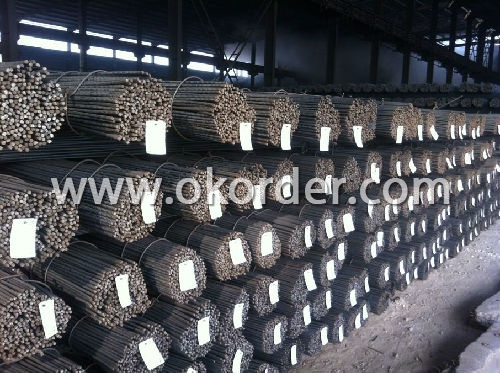
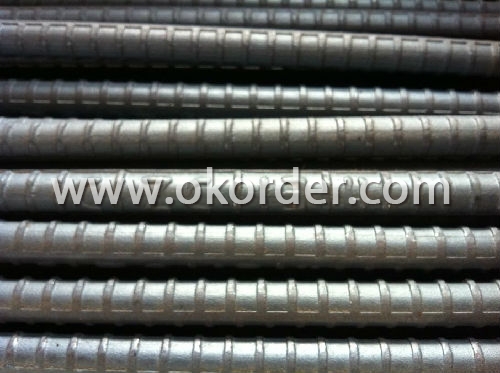
Note:
1. Our products are produced according to national standard (GB), if not, supply according to national standards (GB) or agreement as customer required.
2. Other Grade and Standard Deformed Steel Bar we can supply:
Grade: GR40/GR60, G460B/B500A/B500B/B500C,BST500S
Standard: ASTM, BS, DIN
The Minimum Order Quantity of these products is high, and need to be confirmed.
3. We can not only supply Deformed Steel Bar; if you need anything about building materials, please contact us for further information.
4. Please send us your detail specifications when inquire. We will reply to you as soon as possible. We sincerely hope we can establish a long stable business relationship.
- Q: What are the guidelines for the proper spacing of steel rebars in slabs?
- The guidelines for the proper spacing of steel rebars in slabs are crucial to ensure the structural integrity and strength of the concrete slab. Here are the general guidelines to follow: 1. Rebar Diameter: The diameter of the steel rebar should be determined based on the load and design requirements. Common rebars sizes range from 6mm to 32mm. 2. Spacing: The spacing between rebars is determined by the thickness of the slab and the design specifications. As a general rule, the spacing should not exceed three times the slab thickness. For example, if the slab thickness is 150mm, the maximum spacing between rebars should be 450mm. 3. Edge Distance: The distance between the rebar and the edge of the slab is also crucial. The minimum edge distance should be at least 50mm to prevent cracking and ensure proper load distribution. 4. Clear Cover: The clear cover refers to the distance between the rebar and the surface of the slab. It is essential to provide sufficient clear cover to protect the rebar from corrosion. The clear cover requirements vary depending on the environmental conditions, but commonly range from 20mm to 40mm. 5. Reinforcement Ratio: The reinforcement ratio is the amount of steel reinforcement used per unit area of the slab. This ratio is determined by the load requirements and the design specifications. Typically, the reinforcement ratio ranges from 0.5% to 2%. 6. Lap Splicing: In cases where the length of the rebar is insufficient, lap splicing is required. The lap length should be determined based on the rebar diameter, grade, and design requirements. 7. Placement: The rebars should be placed accurately and securely inside the slab formwork. Proper alignment and placement ensure that the rebars are positioned correctly to resist the anticipated loads. It is important to note that these guidelines are general and may vary depending on the specific project, structural design, and local building codes. It is recommended to consult with a structural engineer or refer to the relevant building codes and standards for precise guidelines specific to your project.
- Q: How do steel rebars contribute to the durability of a structure?
- Steel rebars contribute to the durability of a structure by reinforcing and strengthening concrete. They provide structural integrity, increase resistance to bending and cracking, and enhance the overall load-bearing capacity of the building. The steel rebars help distribute the applied loads evenly throughout the structure, preventing potential failures and ensuring long-term durability.
- Q: How do steel rebars prevent corrosion in concrete structures?
- Passivation is a crucial process in preventing corrosion in concrete structures, and steel rebars are the key components responsible for this. By forming a thin oxide layer on their surface, the rebars act as a barrier against corrosion-causing agents. When embedded in concrete, steel rebars benefit from the alkaline environment created by the cement paste, which aids in passivation. The concrete's high pH level prompts the formation of a protective layer of iron oxide, effectively shielding the rebars from moisture and oxygen. Moreover, well-constructed concrete possesses a dense and impermeable nature that restricts the movement of water and other corrosive substances towards the rebars. Consequently, the likelihood of corrosion initiation and progression is significantly reduced. In addition to the alkaline environment and concrete's impermeability, steel rebars are commonly coated with epoxy or zinc, providing an extra layer of protection. These coatings enhance the steel's resistance to corrosion, especially in aggressive environments like marine or chloride-rich conditions. To ensure the long-term prevention of corrosion in concrete structures, regular maintenance and preventive measures are essential. Proper concrete cover over the rebars and the avoidance of excessive moisture or chloride ions are crucial factors in this regard.
- Q: How do steel rebars affect the flexibility of a concrete structure?
- Steel rebars enhance the flexibility of a concrete structure by providing tensile strength. This reinforcement prevents cracking and increases the overall durability and load-bearing capacity of the structure.
- Q: How do steel rebars perform in heavy load-bearing structures?
- Steel rebars perform exceptionally well in heavy load-bearing structures. Due to their high tensile strength and durability, they provide crucial reinforcement to concrete, effectively distributing and resisting heavy loads. This ensures structural integrity, preventing deformation and collapse even under extreme conditions.
- Q: Can steel rebars be used in structures with high aesthetic requirements?
- Indeed, structures with high aesthetic standards can make use of steel rebars. Although steel rebars are mainly employed for their robustness and longevity, they can also be fashioned and integrated in a manner that satisfies aesthetic necessities. Rebars have the potential to be molded, curved, or even coated to align with the desired visual appeal of the structure. Furthermore, they can be concealed within the framework or concealed under alternate materials to preserve a pristine and visually captivating facade. Through meticulous forethought and design, steel rebars can be effectively employed in structures with demanding aesthetic prerequisites without compromising their functionality or visual allure.
- Q: What is the process of painting steel rebars?
- The process of painting steel rebars typically involves several steps. First, the rebars must be cleaned thoroughly to remove any dirt, grease, or rust. This can be done using various methods such as sandblasting, wire brushing, or chemical cleaning. After cleaning, a primer is applied to the rebars to promote adhesion and corrosion resistance. The rebars are then left to dry before the final coating of paint is applied. This final coat can be either a solvent-based or water-based paint, depending on the desired finish and environmental considerations. The rebars are left to dry and cure, and once the paint is fully dried, they are ready to be used in construction projects.
- Q: Can steel rebars be used in bridges and highways?
- Yes, steel rebars can be used in bridges and highways. Steel rebars are commonly used as reinforcement in concrete structures, including bridges and highways, to enhance their strength and durability. The rebars are embedded within the concrete to provide additional tensile strength, which is crucial for withstanding the various loads and stresses that bridges and highways are subjected to. Steel rebars are preferred due to their high strength-to-weight ratio, corrosion resistance, and ability to bond well with concrete. Additionally, they can be easily fabricated and shaped to suit the design requirements of the bridge or highway. Overall, steel rebars are a vital component in the construction of bridges and highways, ensuring their structural integrity and longevity.
- Q: How do steel rebars perform in fire-resistant constructions?
- Due to their inherent properties, steel rebars are highly effective in fire-resistant constructions. The utilization of steel rebars in these structures serves to bolster their fire resistance. Steel possesses a high melting point and exhibits exceptional heat transfer properties, rendering it a dependable material in fire scenarios. When subjected to elevated temperatures, steel rebars do not undergo combustion or emit toxic fumes, crucially ensuring the safety of individuals during a fire incident. Furthermore, steel rebars possess a low coefficient of thermal expansion, signifying that they experience minimal expansion when exposed to heat. This characteristic helps to maintain the structural integrity of fire-resistant constructions, thereby averting potential structural failures during a fire. Additionally, steel rebars boast high tensile strength, which significantly contributes to the overall performance of the structure in fire conditions. This strength enables the rebars to withstand the forces generated by the concrete's expansion due to heat, thereby reducing the risk of cracking or spalling. Moreover, steel rebars can be encased in fire-resistant materials like concrete and fireproof coatings to provide an additional layer of protection against fire. This combination of steel and fire-resistant materials produces a robust system that effectively endures high temperatures and prolongs the construction's structural stability in the event of a fire. In conclusion, steel rebars play a vital role in fire-resistant constructions. Their high melting point, low thermal expansion, and exceptional tensile strength make them a dependable choice for enhancing the fire resistance of structures. By incorporating steel rebars into construction designs, the safety and durability of buildings are significantly enhanced, affording occupants valuable time to evacuate and minimizing the potential for structural damage during a fire incident.
- Q: How do steel rebars affect the overall maintenance requirements of concrete structures?
- Steel rebars, being strong and durable, enhance the structural integrity of concrete structures. By providing reinforcement, rebars help in distributing the load and increasing the resistance to cracking and tension. This leads to reduced maintenance requirements for concrete structures as they become more resistant to wear and tear, environmental factors, and potential structural failures.
Send your message to us
Hot Rolled GB Standard Deformed Steel Rebars for Construction
- Loading Port:
- Tianjin
- Payment Terms:
- TT OR LC
- Min Order Qty:
- 25 m.t.
- Supply Capability:
- 200000 m.t./month
OKorder Service Pledge
OKorder Financial Service
Similar products
Hot products
Hot Searches
Related keywords
